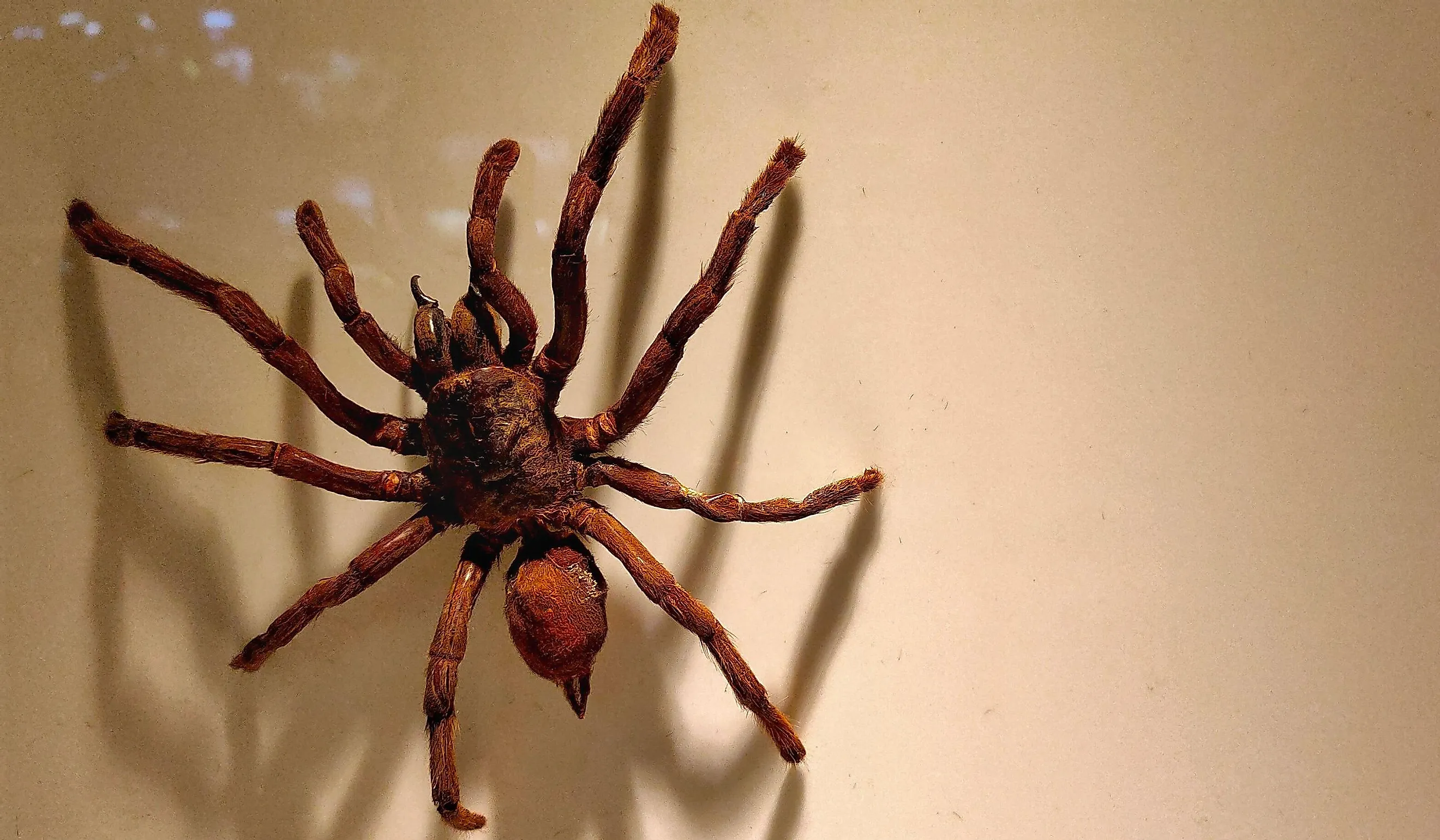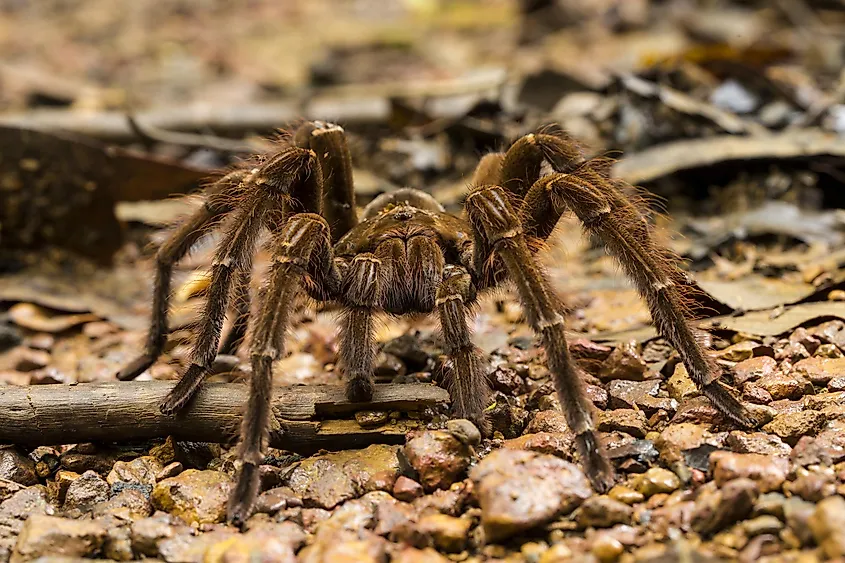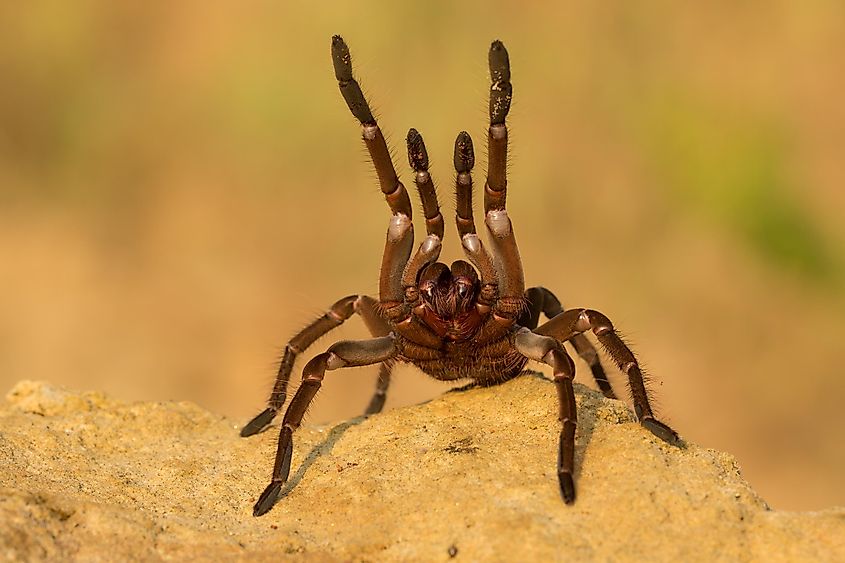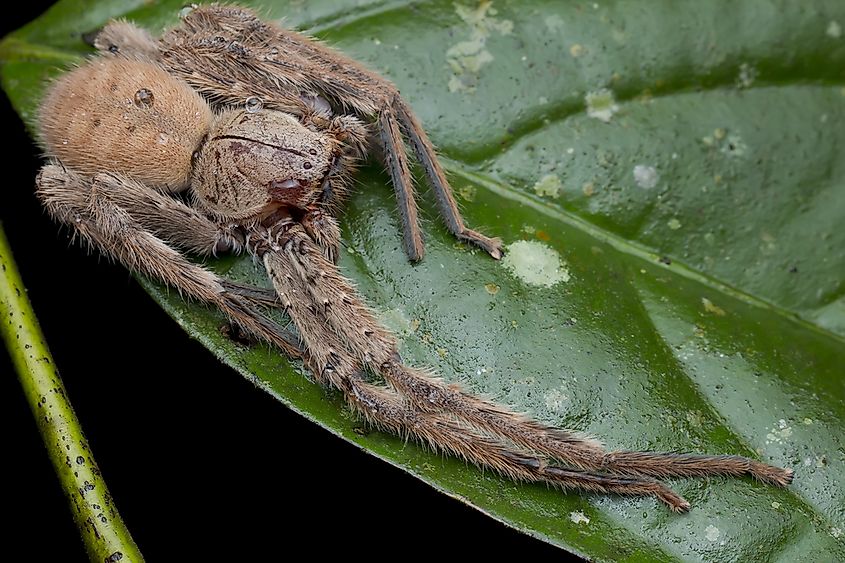
What is The World's Biggest Spider Ever Found?
Have you ever seen the Alien movies? Sure, the Xenomorphs are the main monsters, but they would not exist without the parasitic, spider-shaped face-huggers to latch on to poor human hosts. It's horrifying how a many-legged organism like the face-huggers can grip your head like a sleep-paralysis demon. Can you imagine an actual spider bigger than your hand and almost as wide as your face? At least these nightmares don’t exist, right? Right?
Wrong. Deep in the rain-dark jungles lurks the Goliath bird-eating tarantula (Theraphosa blondi), or the Goliath Birdeater as it is commonly called, the biggest spider ever found. Though not as skinny and pale as face-huggers, these girthy, hairy tarantulas are nearly as big as your face and may as well be bigger than your hands. If tiny spiders already creep you out, then the Goliath Birdeater is a dinner plate-sized nightmare in the flesh. Still, there are many fascinating facts about the Goliath Birdeater that make it an invaluable organism in its ecosystem, and notwithstanding many individuals’ arachnophobia, these tarantulas are nothing to worry about—as long as you do not disturb them, of course.
The Goliath Birdeater: An In-Depth Look

The overall color of the Goliath Birdeater is russet brown to black, and there are distinctive spines on the third and fourth pair of legs. The tarantula's fangs, precisely the size of a cheetah’s claw, fold under the body, distinguishing it as an ambush predator as it must strike downwards to impale its prey. Tarantulas, in general, have four pairs of legs or eight legs in total. In addition, they have four other appendages near the mouth called chelicerae and pedipalps. The chelicerae for the Goliath BIrdeaters contain fangs and venom, while the pedipalps are used as feelers and claws; both aid in feeding.
On average, the Goliath Birdeater’s body measures up to 4.75 inches (12 centimeters) with a leg span of up to 11 inches (28 centimeters). But similar to most arachnid species, female Goliath Birdeaters are much larger and have a longer life span when compared to a male Goliath Birdeater. Males die soon after reaching sexual maturity and have an average life span of 3 to 6 years, whereas a female can live for up to 25 years in the wild.
The Goliath Birdeater’s natural habitats are rainforests, particularly in humid regions of northern South America, including Venezuela, northern Brazil, Guyana, French Guiana, and Suriname. They dwell in burrows beneath the jungle floor, which are lined with spider silk to give the structure more stability. If a hungry spider-eating animal tries to dig up the burrow, T. blondi has a weapon more efficient than venom: urticating hairs or bristles on its abdomen. When provoked, the spider rubs its legs together, launching a fusillade of barbed bristles into the air which irritates and deters potential threats.
Although named “Birdeater” due to an 18th-century engraving showing another member of the tarantula family eating a hummingbird—which gave the entire Theraphosa genus the nickname of “bird eaters”—the Goliath Birdeater rarely devours birds. It mostly hunts for arthropods or small terrestrial animals like mice or lizards during the night. As an ambush hunter, Goliath Birdeater pounces on its prey and injects its inch-long fangs to pump neurotoxins into the hapless victims. The spider then drags the dying animal back to its burrow and begins the digestion process, liquifying the insides and sucking the juices out. Their venom, fortunately, is not harmful to humans—although it is recommended not to provoke the tarantulas since their sting is as harsh as a wasp’s.
The Life of a Giant

The life of a giant begins with the mating of giants. In this case, the larger female Goliath Birdeater must mate with the smaller male. In order to mate, they must first molt. The females especially need to be molted in order to reproduce, or acquired sperm will be lost during the molt. Females molt several times in their lifespan, but a male is rarely seen molting after reaching maturity. After their maturation molt, males develop mating hooks or pedipalps located on the front legs, which they use to latch on to the females’ fangs, which steadies themselves while they mate.
However, mating can be a lethal endeavor for the male. The first step that the male Goliath Birdeater must take is to approach a female’s burrow and entice her out. Because the tarantulas can only sense vibrations and not see their mate, the female often misconstrues the smaller male as potential prey and may try to kill it. Should the male become successful in proving itself as a mate rather than prey by tapping its front legs on the female whilst allowing the female to tap him in turn, then mating can commence. After mating, the male quickly flees lest the female eats him.
Still, males die within a few months after mating, while the females make webs in which they lay 50 to 200 eggs that become fertilized as they pass out of their bodies. The female Goliath Birdeater will wrap her eggs into a ball, and, unlike other species of tarantula, she carries the egg sac with her. Egg sacs are almost the size of a tennis ball and contain around 70 spiderlings, which hatch within 6-8 weeks. These egg sacs are protected by the females’ urticating bristles to stave off predators.
Once the eggs hatch, the Goliath Birdeater spiderlings stay close to their mother until they fully mature at two to three years. During their growth, they undergo several molts in which they shed their old exoskeletons and emerge in new, larger ones. Spiderlings can be expected to molt five or six times in their first year until they reach molting maturity for a new generation of dangerous mating.
Since these spiders are solitary, nocturnal hunters, they rarely encounter one another, and if they do, they confront each other aggressively. They protect their private burrows consistently; although males do fight each other for mating rights on the female, such encounters are rare, and the males worry more about the larger, more ferocious females eating them rather than other males.
Life as a giant is not an easy existence, and it is exacerbated by new and continuous threats. Presently, the International Union for Conservation of Nature (IUCN) has not accurately evaluated the spider population in the South American region. Although the population is considered stable, the species experiences a constant threat from capture and pet trading. Deforestation and habitat loss are also major hazards, exacerbated further by the locals treating the spiders as delicacies to be eaten. Currently, the Goliath Birdeater is not yet an endangered species, though if no conservation methods are promulgated to quell deforestation and poaching, then the species’ survival status may likely change.
Compared with Other Large Spiders

As humungous a spider as the Goliath Birdeater is, it is not the only spider species that takes a titanic title.
By pure leg span alone, the giant Huntsman Spider (Sparassidae), found mostly in Laos, has a leg span of 12 inches whereas the Goliath Birdeater only has a leg span of 11 inches. These spiders are not as wide or girthy as their bulky contenders, but much like the Goliath Birdeaters, Giant Huntsman Spiders do not build webs to await prey, preferring to hunt food down in the undergrowth quickly.
South America—specifically Brazil, Argentina, and Paraguay—boasts another species of big spiders aside from the Goliath Birdeater. The Brazilian Salmon Pink Birdeater (Lasiodora parahybana) hunts insects, amphibians, small birds, and reptiles. Similar to the Goliath Birdeater’s bristles, the Brazilian Salmon Pink Birdeater’s hairs cause irritation if they come into contact with skin. Although size and shape are not enough to properly distinguish between a Goliath Birdeater and a Brazilian Salmon Pink Birdeater (the latter only has a leg span of 10 inches), the Salmon Pink Birdeater’s body is dark brown with bright salmon-colored hairs on its thick legs and abdomen, making it look pink in comparison to the dark-brown bristles of the Goliath birdeater.
Other giant spiders include the Brazilian Giant Tawny Red Tarantula, the Face-Size Tarantula, and, in prehistoric times, Nephila jurassica, found in northeastern China and said to have stretched about two inches from end to end and had a leg span of about 6 inches.
Now all these gargantuan creepy-crawlers, especially the Goliath Birdeater, are products of their evolution and environment. All arachnids developed from various arthropods, among the first organisms to leave the oceans around 450 million years ago. Trigonotarbida, the first known arachnid, is said to have appeared between 420 and 290 million years ago. It resembled modern spiders but lacked the characteristic silk-producing glands.
Millenia later, the Trigonotarbida spawned new generations of spiders around 250 million years ago. Today, there are now two distinguishable infraorders of modern spiders: Araneomorphae and Mygalomorphae. Infraorder Araneomorphae includes 'modern' spiders such as the orb weavers, redbacks, and huntsman spiders. They typically have pincer-like fangs, at least six spinnerets, and one pair of book lungs plus a pair of air tubes (tracheae). It is these spiders that produce webs for trapping prey. In contrast, infraorder Mygalomorphae includes 'ancient' spiders such as tarantulas, trapdoor and funnel web spiders. These spiders have reduced spinnerets, dagger-like fangs, and two pairs of book lungs similar to ancestral ground-living spiders. The Goliath Birdeater and its cousins belonging to these infraorders hunt down prey rather than spin webs to await them.
The Goliath Birdeaters’ niches in the rainforests aided their giant growth. Due to the sheer abundance of food in the South American rainforests and their own evolutionary weaponry and defenses against natural predators, the Goliath Birdeaters did not fear starvation. Their only limitations for further growth were humans who consumed the tarantulas as indigenous delicacies, deforestation, and killing or eating each other.
You close your eyes, and you feel two, four, six, and eight legs tapping along your face, their hairs poking like needles into your pores, its black mass engulfing your face. And when you do open your eyes, you see gigantic, furred fangs beneath small black eyes staring back at you.
Scary, right? But Goliath Birdeaters are far from the horrifying face-huggers of the Alien movies. Their venom and bite—comparable to wasp stings—are not lethal to humans and are necessary predators in the South American rainforests. As a species that may be near endangerment due to habitat loss, poaching, and being sold as exotic pets in faraway countries, these spiders ought to be treated and cared for with proper conservation methods.
Many individuals have an irrational fear of arachnids more than any other organism—and many other creatures are far more dangerous to humans than spiders—in the world. And it is understandable to be afraid of giant, dinner plate-sized spiders like the Goliath Birdeaters. Yet rest assured that these behemoths are in no way life-threatening. Terrifying to some, yes. Dangerous and monstrous to all, no. They may be good at killing pests like rodents, but it is not recommended to keep one as a pet or transport them elsewhere as an invasive species in different environments.











